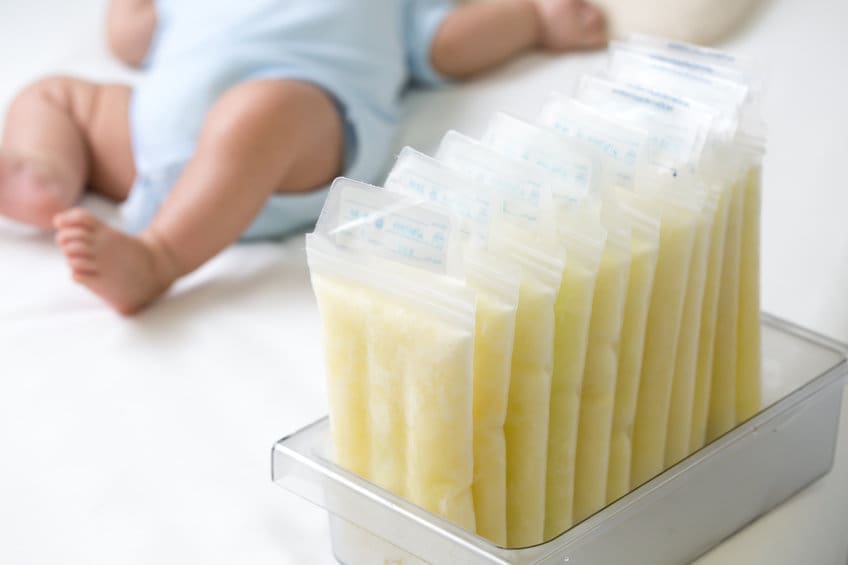Info from www.childrens.com:
Dawn Schindler, RN, BSN, IBCLC, is a lactation consultant at the Level IV Neonatal Intensive Care Unit (NICU)at Children’s Health℠. She answers commonly asked questions about how to store expressed (pumped) breast milk.
What is the best way to store breast milk?
Breast milk can be stored in any clean container with a lid. Be sure to label all expressed milk clearly with the date and time it was pumped and triple-check that the container is tightly sealed.
There are many safe and convenient products on the market to help parents store breast milk before baby needs it, including:
- Breast milk storage bags (preferred over regular snack or sandwich bags)
- Glass or plastic bottles with caps
“Don’t rely on the bags to measure the volume of your milk accurately,” Schindler says. “Measure it in the bottle and then along with the date and time, write the amount on the bag so you know exactly how much milk is in each bag.”
Be sure to check with your baby’s daycare or caregivers to find out what needs to be included on the breast milk label. If your infant is being cared for in a NICU or another area of a hospital, there may be specific requirements for labeling expressed breast milk, including:
- Baby’s name and date of birth
- Mother’s name and date of birth
- Time and date of pumped milk
- Any prescription or over-the-counter medication the mother took
How long can I store breast milk?
The Centers for Disease Control and Prevention (CDC) recommends storing breast milk in the refrigerator for up to four days and in a deep freezer for 6-12 months.
Find a place in the back of the refrigerator where it’s colder and has less of a chance of getting knocked over. In the deep freezer, it’s helpful to keep all breast milk together so it’s easy to find. Wherever you store it, organize milk with the oldest in front to make sure you use it before it expires.
One tip Schindler recommends to all moms who want to freeze their breast milk is to freeze milk in the volume your baby is taking in. “Don’t put 8 ounces in a bag if your baby is only drinking 4 ounces at a time” she explains. “This helps make sure you thaw the right amount and avoid wasting milk.”
How long can fresh pumped breast milk stay out?
Fresh pumped breast milk can stay out at room temperature for about four hours before it is fed to baby or put in the refrigerator. Schindler suggests parents make a note indicating the time the breast milk was pumped and put it in a place where you won’t forget about it.
Can I mix breast milk from different pumping sessions?
Yes, moms can combine and store breast milk from different pumping sessions.
Schindler recommends adding cold breast milk to cold breast milk. “Store it in bottles in the fridge and once it’s all the same temperature, you can put it in one bottle or a bag.” Be sure to label the milk with the date and time from the first pumping session.
Can I refrigerate breast milk after feeding?
According to the CDC, moms can save breast milk for two hours after feeding. After that, parents should toss leftover milk to avoid the risk of bacteria from growing in the nipple of the bottle.
How can I safely defrost milk?
Start defrosting frozen milk by placing it in the refrigerator. Once there are no more chunks or ice crystals in the milk, it is considered thawed. You can keep thawed milk for 24 hours in the refrigerator.
Schindler reminds parents that thawing milk can take several hours or even up to a day. If you need to defrost milk more quickly, you can thaw milk in a bowl of lukewarm water. Once the milk is liquified, you can continue to warm the appropriate volume for feeding. The remaining volume can be refrigerated for up to 24 hours.
One final note of caution: After thawing once, breast milk should never be frozen again.
What if my breast milk smells after defrosting?
The food we eat and the enzymes in our body can alter the smell of breast milk. “Most of the time, babies don’t notice a small change in taste or smell,” Schindler says. “If your baby does refuse defrosted milk, try mixing it with freshly expressed milk.”
If you continue to notice a different smell to fresh or defrosted milk, talk to your baby’s pediatrician or with a lactation consultant.
Do I have to warm up breast milk before feeding?
Newborns tend to prefer warmed milk, but as they get older, preferences may change and cooler or room temperature milk may be accepted. If your child prefers warm breast milk, you can warm milk in a cup or bowl of warm water – never in the microwave.
How can I safely transport expressed breast milk?
When it’s time to go to a grandparent’s house or if you’re heading to the NICU to see your little one, follow some simple storage advice to keep your milk safe on the trip.
Place all the expressed milk you need in a cooler packed tightly with ice or ice packs. Avoid the temptation to open the cooler to check on it during the trip. Breast milk can be kept in a cooler, on ice, for about 24 hours.
The guidelines for pumping and storing breast milk may feel overwhelming at first, but you have resources available to help. Ask a physician or lactation consultant for support if you have questions as you work to feed your little one.


